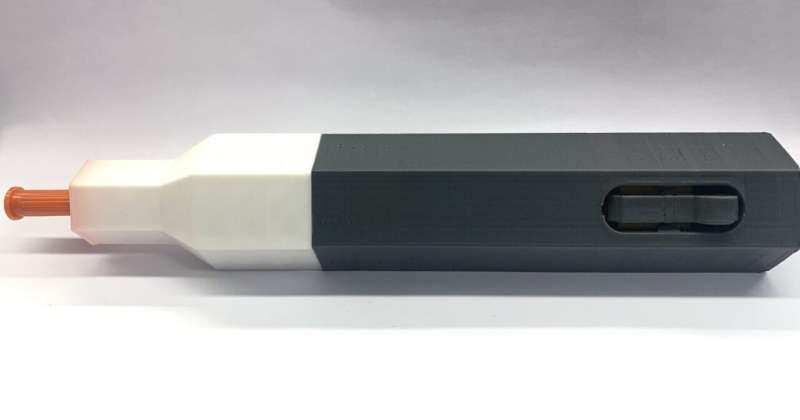This article has been reviewed according to Science X's editorial process and policies. Editors have highlighted the following attributes while ensuring the content's credibility:
fact-checked
peer-reviewed publication
trusted source
proofread
Research team creates open-source medicine autoinjector—for a tenth of the cost

Sir Frederick Banting was clearly ahead of his time. He is also an inspiration for a new open source self-administering drug delivery device. Long before open source was an option or even a concept, the now-celebrated former Western lecturer refused to patent insulin because he wanted it to be inexpensive and widely available for the betterment of all.
Now, 100 years after Banting won the Nobel Prize for his discovery, Western researchers are at it again. A team led by engineering and Ivey Business School professor Joshua Pearce has developed a new 3D printed, completely open-source autoinjector—a device designed to deliver a single dose of medicine—for a tenth of the cost of a commercially purchased product.
A new study, published July 14 in the journal PLOS One, describes the manufacturing design of the spring-driven device, which could cost less than $7 to make while a store-bought version is closer to $70.
"I think of this device, like so much of what we're doing here at Western, very much as following the golden rule: do unto others as you would have them do unto you," said Pearce, the John M. Thompson Chair in Information Technology and Innovation at Western. "It makes the world slightly better to have an open-source version of an autoinjector, especially for people who don't have access or the financial means to purchase a proprietary one."
Autoinjectors are used all over the world by health care practitioners, patients and parents (for children under 12) to inject insulin into people with diabetes. Other chronic conditions such as psoriasis, multiple sclerosis and rheumatoid arthritis can also be treated using an autoinjector. The device is also essential during emergency conditions for migraine, anaphylaxis and status epilepticus patients, as well.
Pearce, along with research assistant Anjutha Selvaraj and post-doctoral associate Apoorv Kulkarni from Western's Free Appropriate Sustainability Technology (FAST) research group, have created the new open-source autoinjector to make the device—considered more reliable and easier to operate than a simple syringe for self-administering medications into the body—an equitable alternative to the more expensive options.
Studies show self-administration of medications by patients improves compliance and comfort and empowers patients as they are actively involved in their personal care. It also allows patients to avoid time-consuming and costly visits to the hospital, which is a bonus for overburdened health care systems.
And, as with all open-source hardware, there is money to be made as the digitally replicable device enables low-cost distributed manufacturing. All materials, designs and assembly instructions are also detailed in the new study, and the effectiveness of the autoinjector is tested against the current standard (ISO 11608-1:2022) for needle-based injection systems. It is released with an open source hardware license. Companies wishing to commercialize the device will still need to meet their own local regulatory requirements.
"Does this design make it possible for other people to commercialize it anywhere in the world? Yes, it does," said Pearce. "But more importantly, it means we can really target isolated communities, whether they're in northern Canada, Africa or anywhere in else in the world, and improve health care access for everyone."
More information: Anjutha Selvaraj et al, Open-source 3-D printable autoinjector: Design, testing, and regulatory limitations, PLOS ONE (2023). DOI: 10.1371/journal.pone.0288696




















